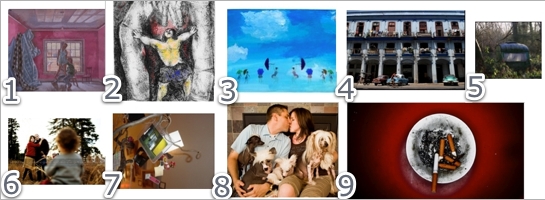Four interesting story-related finds that have come across my computer screen in the past few days:
Rooftop Confessions: I’ve blogged about sites where folks can tell their personal stories, including sites like Alpha Women, which logs rather racy confessions. But this is the first site I’ve seen in which confessions are recorded in both text and video. Here are some words on what the site is all about:
Rooftop Confessions are literally public confessions of private
experiences…all of which are delivered from rooftops across the country. … User-driven and fully interactive, let Rooftop Confessions be your cyber-diary for the Web 2.0 world.
The folks behind the site use words like “embarrassing,” “lewd,” and “sordid” to describe the confessions. Users get to “Forgive” or “Condemn” each confession. I particularly enjoyed the founders’ description of themselves (these points seem to capture the spirit of the confessions sought):
- We’re the guy down the hall who stole your Playboy subscriptions throughout most of 2007.
- We’re the girl who had a spring-break fling with your fiancée while you were home with the flu.
- We’re the pizza delivery guy who’s had a major crush on you for the past 3 years.
- We’re the old lady who keyed your car just for the hell of it.
- We’re the younger brother who read your diary when you went off to college.
- We’re the waitress who served you tap water even though you ordered Evian.
- We’re the neighborhood kids who put bags of flaming feces on your porch last Halloween.
- We’re the young co-ed who used sex to get out of a speeding ticket.
- We’re the friend who shamelessly slipped meat into your vegetarian burrito.
- We’re the sister who accidentally killed and secretly replaced your goldfish while house-sitting for you last week.
- We’re the guy who lied about being Jewish just to get into your pants.
- We’re the coworker who sabotaged your project in order to get a promotion
One Million Monkeys Typing: As you can probably guess, this site is inspired by the “infinite monkey theorem,” which states that a monkey hitting keys at random on a typewriter keyboard for an infinite amount of time will almost surely type or create a particular chosen text, such as the complete works of Shakespeare. It works like this, according to the site’s founders:
This site attempts not only to harness the literary power of one million “monkeys” typing but also to generate some truly wonderful texts and social networks. It is part Exquisite Corpse, part Choose Your Own Adventure, and it works by having multiple authors work on the same stories with each adding their own segments. Each segment (or snippet) will have the opportunity for 3 offshoots — those that are ranked highly will gain offshoots of their own, and those that are ranked poorly will wither and die.
30 Unusual Innovations in Storytelling from TrendHunter Magazine. A few of these I knew about and have even blogged about, but most were new to me. You can see them either as a slideshow or photo gallery. The innovations range from t-shirts and other fashion to street art to virtual mixed-media scrapbooks. Or how about a story tattooed in words across the bodies of 2,095 strangers? Or a video that depicts a completely different storyline when played in reverse vs. forward?
Storytron: This is a complex interactive storytelling tool that I don’t totally  grasp, involving Storytronics, software called The Storyteller, SWAT (the Storyworld Authoring Tool), Diekto (a simplified form of English used by the Storyteller), Sappho (the scripting language the author uses to create a storyworld), and Storyengine, the brain of the Storyteller. See? Complex.
grasp, involving Storytronics, software called The Storyteller, SWAT (the Storyworld Authoring Tool), Diekto (a simplified form of English used by the Storyteller), Sappho (the scripting language the author uses to create a storyworld), and Storyengine, the brain of the Storyteller. See? Complex.
And here’s what Storytron is not and is not similar to: interactive fiction/choose your own adventure, videogames or massively multiplayer online role-playing games (MMORPGs), The Sims, Second Life, or literature. What it is: “A sophisticated new technology that employs computer-generated actors in a social learning environment.” Apparently it can also be used for corporate e-learning, in which “Storytronic e-worlds are peopled by savvy, computer-generated Actors who teach your employees the hard lessons in a safe, simulated setting–so they don’t learn them on your customers.” The corporate slide show gave me my best understanding of Storytron, which is good because my hatred of games will probably preclude further exploration.








